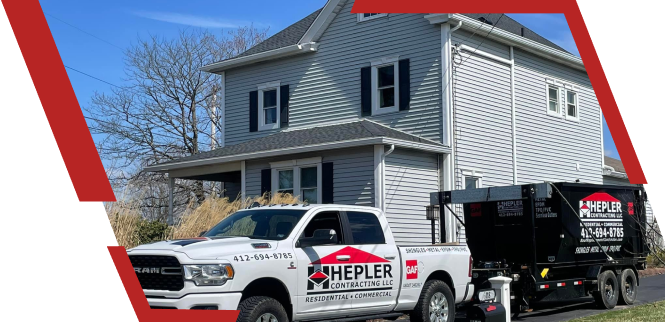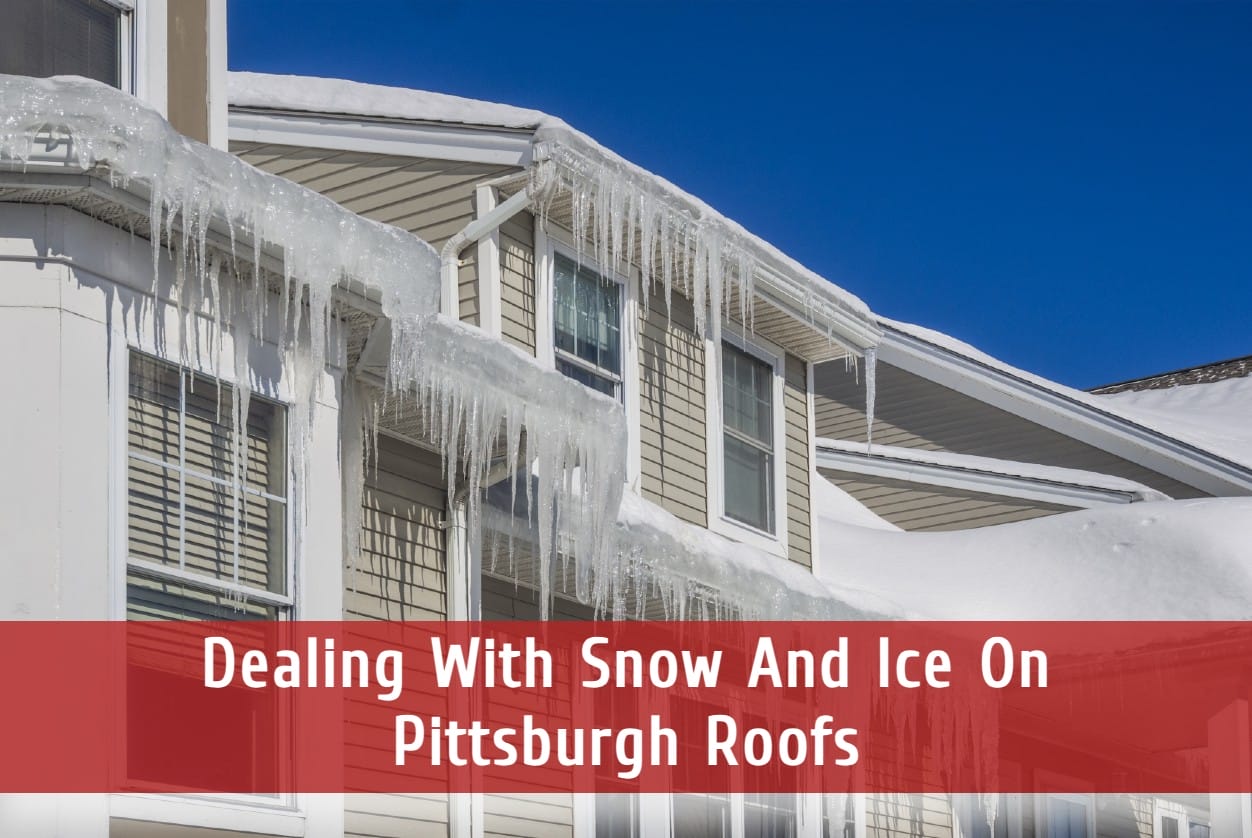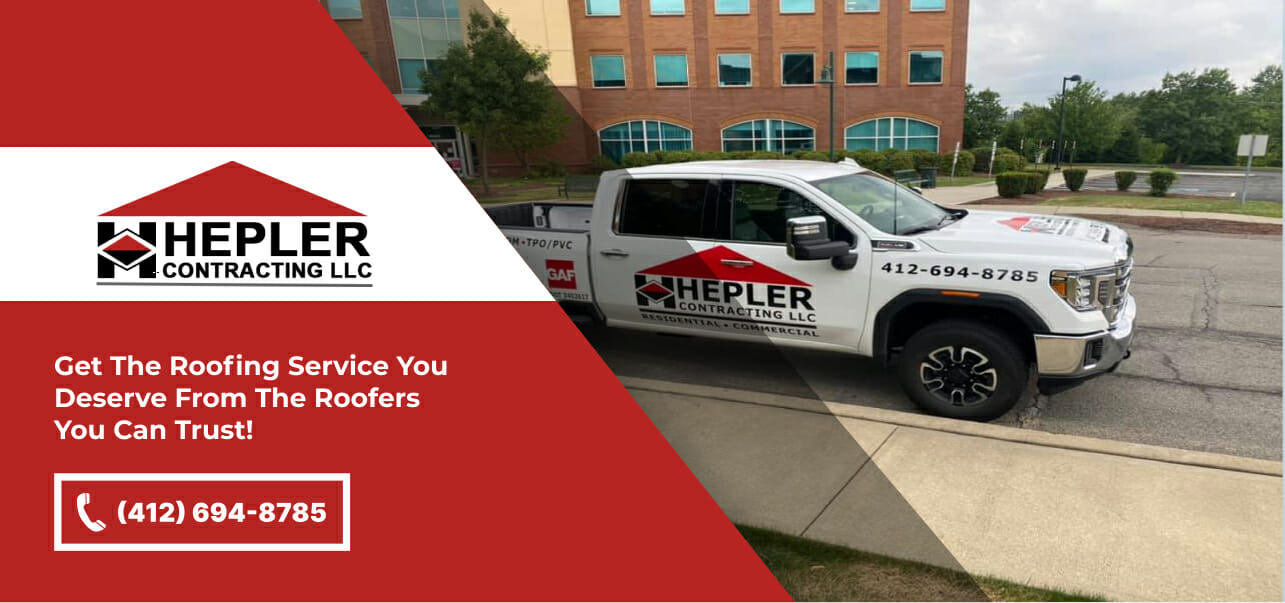Are you a homeowner in Pittsburgh who’s worried about the upcoming winter season? Luckily, we’re here to help with ways you can protect your home from the harsh winter weather. Snow and ice buildup can cause serious damage to your roof, leading to expensive repairs; but with our expert tips and advice, you can prevent damage and keep your roof safe all winter long. Don’t let snow and ice take over your home, take control with these helpful tips.
Key Points:
- Regular roof inspections and prompt repairs are crucial to preventing structural damage and water leaks caused by snow and ice buildup.
- Ice dams can cause significant damage to roofs and should be addressed by a professional roofing contractor.
- Proper insulation, ventilation, and regular maintenance of gutters and downspouts can help prevent snow and ice buildup on your roof.
Why Is Snow And Ice Removal Important For Pittsburgh Roofs?
Snow and ice removal is crucial for Pittsburgh roofs to prevent ice dams, leaks, and structural damage. Regular roof inspections and timely roof repair can mitigate potential issues. Emergency roof repair services, such as those offered by companies like Hepler Contracting, can address urgent concerns. However, reducing the risk of damage and developing a plan of action for snow and ice removal ensures the longevity of your roof and prevents emergency repairs.
What Are The Potential Risks Of Snow And Ice Buildup On Your Roof?
As winter approaches, homeowners in Pittsburgh need to be aware of the potential risks that snow and ice buildup can pose to their roofs. From structural damage to leaks, snow and ice can cause a variety of issues if it’s not properly managed. In this section, we will discuss the various risks associated with large amounts of snow and ice on roofs, including the dangers of structural damage, roof leaks, water damage, and the formation of ice dams. By understanding these risks, homeowners can take necessary precautions to protect their roofs from potential damage.
1. Structural Damage
- Assess structural integrity to ensure the roof can support heavy snow loads.
- Manage weight distribution to prevent excessive strain on the roof, especially roofs that have a shallow pitch.
- Inspect and reinforce pitched roofs to better withstand heavy snow accumulation.
2. Roof Leaks and Water Damage
During harsh winters, homeowners may experience roof leaks due to heavy snow accumulation. This is typically a sign of a bigger problem, sometimes requiring emergency roof repair services. Exterior roofing material may become weak, leading to water damage that will appear in the home. By quickly responding, you can prevent structural issues from occurring.
- Inspect the roof for signs of damage, such as cracked, curled, or missing shingles.
- Repair any damaged areas promptly to prevent water from seeping into the roof’s structure.
- In case of severe damage, seek emergency roof repair to mitigate water damage.
- Check exterior roofing material for any vulnerabilities that could lead to leaks or water damage.
3. Ice Dams
Ice dams are formed when the roof is at an uneven temperature. As snow melts from the roof’s peak, where it’s the warmest, and runs down to the edges of the roof, where it’s the coldest, it freezes. As this cycle repeats and more water accumulates, this ice dam becomes heavy and puts immense strain on your roof. They can especially harm your gutters.
- Use a roof rake to remove excess snow from the roof’s edge.
- Carefully break up and remove ice dams to avoid damaging the roof deck and other parts of the roofing structure.
- Ensure proper insulation and ventilation to prevent ice dams from forming.
What Are The Best Practices For Snow And Ice Removal?
The careful and prompt removal of the snow and ice that’s accumulated on your roof is crucial to maintaining its structural integrity and preventing any potential damage.
1. Use The Appropriate Tools and Techniques
- Use a roof rake with a long handle to safely remove snow without having to climb onto the roof.
- Utilize snow removal tools like snow shovels or pushers to clear large amounts of snow away.
- Apply de-icing products or salt to melt ice and prevent further accumulation.
- Employ proper techniques to avoid damaging the roof while removing snow and ice, such as shoveling parallel to the roof’s slope.
2. Clear All Gutters and Downspouts
If you notice your gutters and downspouts are clogged with leaves and debris, it’s important to clear these as soon as possible. Clogged gutters will cause water to back up and freeze, leading to leaks into the home, damage to the gutters, and harm to the roof.
- Inspect gutters and downspouts for debris and blockages regularly, especially in the fall before winter starts.
- Use a sturdy ladder and appropriate safety gear to clean gutters and downspouts.
- Remove leaves, branches, and other debris that’s accumulated to ensure proper water flow.
- Consider installing gutter guards to prevent debris buildup and clogging.
3. Consider Professional Help
- Research reputable roofing contractors in your area with experience in snow and ice removal.
- Ensure the contractor has proper insurance and certifications.
- Discuss the removal process, safety measures, and potential preventive maintenance with the roofing contractor.
How To Prevent Snow And Ice Buildup On Roofs?
Now that you know the harm that snow and ice buildup can cause to a roof, you may be wondering how you can prevent it from happening in the first place. Taking precautionary steps can go a long way, so always employ preventative measures such as using proper ventilation.
Here are the ways that you can prevent snow and ice buildup:
1. Install Proper Insulation and Ventilation
- Assess insulation: Ensure proper insulation to prevent heat loss and subsequent snow melt.
- Check ventilation: Adequate attic ventilation is crucial to maintain a consistent roof temperature and prevent ice dams.
- Seal air leaks: Address any gaps or leaks to maintain the effectiveness of insulation and ventilation.
2. Keep Gutters and Downspouts Clean
- Regular Cleaning: Remove debris and leaves from gutters and downspouts using a trowel or scoop. Ensure proper drainage to prevent ice dams.
- Inspect and Repair: Check for any leaks, corrosion, or sagging. Repair any damaged or rusted sections promptly.
- Install Gutter Guards: Consider adding gutter guards to prevent debris buildup and clogging.
3. Trim Overhanging Tree Branches
- Inspect: Regularly check for overhanging tree branches.
- Trim: Safely prune branches to prevent damage from heavy snow or ice.
- Hire Professionals: If the task is challenging, seek assistance from certified arborists.
Trees that have branches too close to your roof may provide nice shade in the summer but will wreak havoc on your home if not properly maintained in the fall. Ensuring branches are trimmed and all leaves are cleared from the roof and gutters will help protect your home during the chilly winter months.
4. Use a Roof Rake to Remove Snow
- Choose a roof rake with a long handle and a non-abrasive blade.
- Start from the edge and work your way up, gently pulling the snow towards you.
- Avoid pulling the snow towards the center of the roof to prevent damage.
- Use caution to prevent injury or damage to the roof.
What Do You Do If You Notice Damage From Snow And Ice On Your Roof?
If you’ve happened to remove the buildup of snow and ice yourself, and notice signs of damage it’s important to take immediate action. Here is what you can do:
Document the Damage
- Document the Damage: Take clear photographs and videos of the snow and ice damage on your roof from multiple angles.
- Write a detailed description of the damage, including the date and time it was noticed.
- Keep all related documents and receipts in a safe place for insurance and professional assessment purposes.
Contact a Professional Roofing Company
- Reach out to a professional roofing company with experience in emergency roof repair.
- Ensure that the chosen company is licensed and insured for the repair work.
- Request an assessment of the snow and ice damage, and discuss repair options.
Take Steps to Prevent Future Damage
After contacting a professional roofing company, they’ll establish the problems with your roofing system and advise the proper solution.
- Regular Roof Inspections: Schedule yearly inspections to identify and address any potential issues early.
- Improve Insulation: Enhance insulation to prevent heat from escaping and causing snow to melt and refreeze.
- Proper Ventilation: Ensure attics are properly ventilated to maintain consistent temperature across the surface of the roof.
- Trim Tree Branches: Regularly trim overhanging tree branches to prevent gutters from being clogged.
- Install Heating Cables: Consider using heating cables along the edge of your roof to prevent ice dams and snow buildup.
Professional Roofing Services In The Pittsburgh Region
If your home has had trouble with ice dams in the past, or you’re looking to repair and reinforce your home before the winter weather sets in, contact Hepler Contracting to help! We’ve been assisting residents in Pittsburgh, and the wider region of Pennsylvania for years, and want to help you! We’ve seen how the winter weather affects members of our community, which is why we ensure that every finished project exceeds expectations and provides you with exactly what you need. Contact us today at to see how we can help.
FAQs About Dealing With Snow And Ice On Pittsburgh Roofs
How much snow can a roof hold?
The amount of snow a roof can hold depends on various factors such as the roofing materials, shape of the roof, and structural integrity of the roof. It is recommended to start removing snow when it has accumulated 18 inches or higher.
What roofing materials are best for handling snow loads in Pittsburgh?
Metal and slate roofs are the best choice for handling snow accumulation in Pittsburgh. These heavy and durable materials can bear the weight of a lot more snow compared to wood or asphalt roofs.
How does the shape of a roof affect its ability to hold snow?
A roof with a steep pitch allows snow to slide off it easily, while a shallow or flat roof is at risk of damage from heavy snow accumulation. Additionally, uneven snow accumulation on a roof can also pose a risk of structural failure.
Should I be concerned about ice dams on my roof?
Yes, ice dams can cause water to pool on your roof, potentially leading to leaks and damage to your roofing materials. It is important to address ice dams promptly to prevent further damage.
What is the best way to remove ice dams from my roof?
It is not recommended to chip away at ice dams yourself as this can cause damage to your roofing materials. Instead, crank up the heat in your house and seek professional help from a roofing contractor like Hepler Contracting.
Can chemical solutions be used to remove ice dams?
No, it is not recommended to use calcium chloride or rock salt to melt ice dams. These chemicals can cause staining and permanent damage to your roofing materials. It is best to seek professional help for the safe and effective removal of ice dams.


